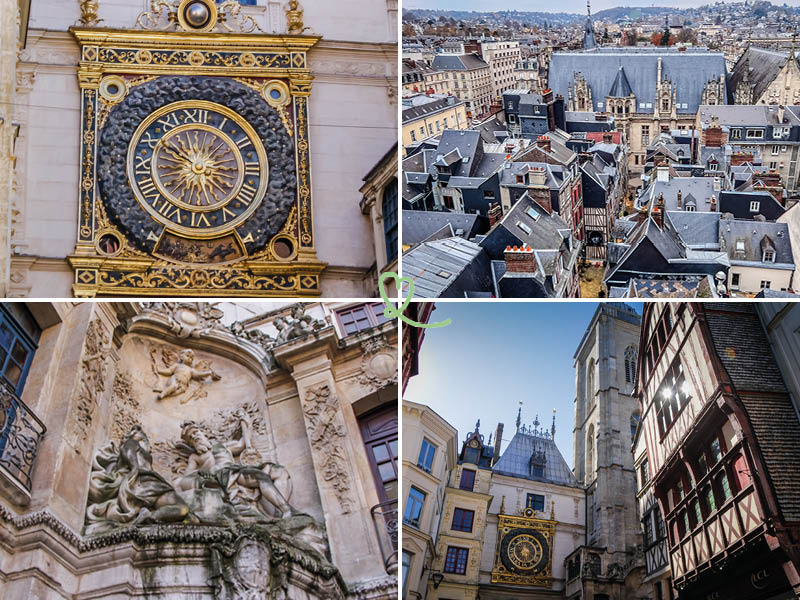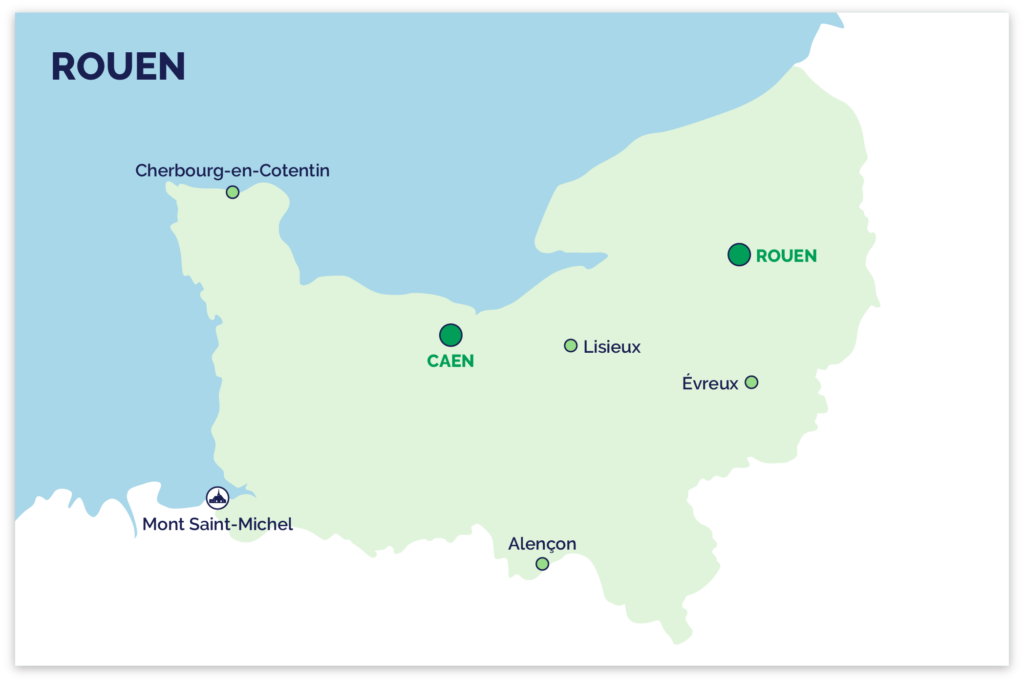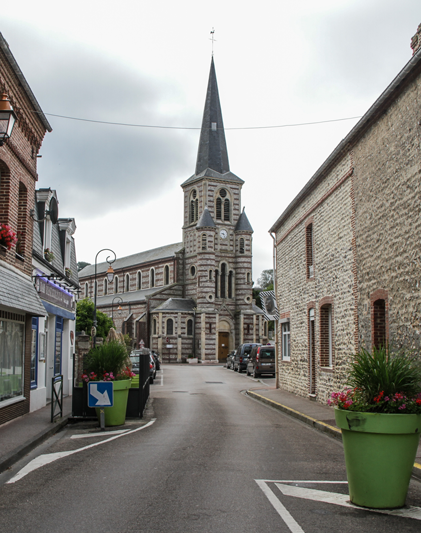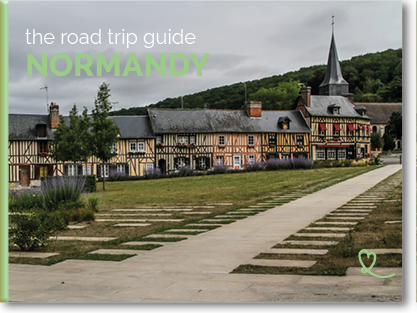Are you planning to visit Rouen’s Gros Horloge? You’re absolutely right! THe clock tower undoubtedly the symbol of the Normandy capital. You won’t be able to miss it as you pass along Rouen’s main pedestrian thoroughfare, rue du Gros-Horloge. The Gros Horloge is a monument consisting of a Renaissance-style arch spanning the street, and a belfry housing the town’s bells. It is best known for its 14th-century astronomical clock, one of the oldest clock mechanisms in Europe!
Don’t wait any longer to discover our tips for planning your visit, and enjoying the sublime panorama offered by the Gros-Horloge from the top of its belfry!

This review is completely independent, we visited anonymously and paid our admission in full.
Why visit Le Gros Horloge, Rouen’s clock Tower?
Is the Le Gros Horloge museum worth it? Our opinion:
Absolutely! If you can admire the clock of this historic monument from the Gros Horloge shopping street, it would be a shame not to visit. The history and architecture of this monument will hold no secrets for you, and you’ll learn a lot about the importance of Rouen during the Renaissance. For example, we learned that Rouen was France’s 2nd largest city until the 17th century, no less!

We were fascinated by the clock mechanism and the discovery of the bells. What an opportunity to observe them from the inside! Last but not least, the Gros-Horloge is the monument with the finest panoramic view of Rouen. For all these reasons, we’ve listed this visit among our 15 ideas for things to do in Rouen.

Why is Le Gros Horloge famous?
Rouen’s emblem, the Gros-Horloge, is famous both in France and abroad, and with good reason! Its astronomical clock is one of the oldest in Europe, and its mechanism is highly complex and still in working order. Its single hand indicates the time, while a globe above the dial indicates the lunar phases and a deity appears below the number VI to indicate the day of the week. It is closely linked to the town and its historic district, housing the first municipal bells and gracing the rue du Gros-Horloge. This shopping street, linking the Place du Vieux-Marché to the sublime cathedral, is Rouen’s most famous.

Our favorite moments
We were charmed by this visit. We particularly enjoyed discovering the clock mechanism, which is a true jewel of engineering. The explanations of the different sections of the dial were also very interesting and gave us a better understanding of how it works. But what really made the difference was the breathtaking view of Rouen and its magnificent cathedral from the top of the tower. It was a magical moment that we loved.

Subscribe to our Newsletter
- Get away from it all with Region Lovers’ beautiful destinations!
- Once a month
- Advertising-free
History in brief
Rouen’s Gros-Horloge is one of the city’s most emblematic monuments. While the church is famous for its 14th-century sundial, its belfry dates back to the 13th century. It replaces a tower razed to the ground by Charles VI following the Harelle revolt. This popular revolt against tax oppression dates back to 1382. In losing their building, the people of Rouen also lost their bells. They asked for a new tower to house a clock. This became a belfry, a symbol of communal power, and the bells were reassembled.

A wooden pavilion was added in the Renaissance, followed by a fountain and a clockmaker’s workshop in the Classical period. There was a succession of governors in charge of the clock, before the adoption of an electric system. Classified as a historic monument in 1862, extensive restoration work was carried out from 1997 until the monument was opened to the public in 2006.

Practical tips and map: Le Gros-Horloge, Rouen, France
Where is Le Gros-Horloge?
Le Gros-Horloge is located rue du Gros Horloge in Rouen (76000), Normandy.

- Driving time from Evreux: 55min
- Driving time from Caen: 01h30min.
- Driving time from Alençon: 01h45min.
- Driving time from Cherbourg: 02h50min.
- Driving time from Paris: 02h20min.
How to get there
The Gros-Horloge is located in Rouen’s historic district, where traffic is difficult, especially at rush hour. If you’re coming from the Paris region or Normandy, prefer the train. Rouen railway station has a regular TER line serving Paris (between 1h15 and 1h30) and the main towns in Normandy (Caen, Le Havre…).
See available timetables and book your train and coach tickets now.
From the station, it’s just a 10-minute walk to the monument. Take the cobbled Rue du Gros Horloge from Place de la Cathédrale or Rue Jeanne d’Arc.

For public transport, the nearest metro stop is “Palais de Justice”. There are also several bus stops nearby, such as “Cathédrale” and “Théâtre des Arts” (TEOR lines 1, 2 and 3 / lines 11, F2, F7).
To plan your journey, please visit the official Rouen Normandie transport network website.
Last but not least, you can rent bicycles in the city 24/7. Cy’Clic stations at Place du Vieux Marché, Square Verdrel / Beaux Arts and Cathédrale are in the immediate vicinity of the Gros-Horloge. There’s also a bike park at the Palais de Justice.

Parking
If you’re coming by car, we recommend parking in one of the public parking lots in the city center and walking to the Gros Horloge. Rue du Gros Horloge is a pedestrian thoroughfare. The nearest parking lots are Parking de la Pucelle, Parking des Carmes and Parking Bouvreuil.
OUR ADVICE FOR RENTING A CAR IN Normandy
- Compare prices on our preferred platform: DiscoverCars – one of the best rated sites.
- Choose a car that is comfortable enough (distances can be long) but compact (some parking lots and villages are narrow).
- Think of thecomplete insurance (some roads are tortuous and narrow).
- There is a lot of demand, book it early.

Best time to visit
The best time of year to visit the Gros Horloge is probably spring or summer, when the days are longer and the weather is generally milder.
This monument is a very popular attraction, so there can be queues, especially during peak times, between 10 and 11 am and between 2 and 5 pm. If you can, avoid going at weekends and during school vacations.

How long does it take to visit the Gros Horloge and what are the main difficulties?
The visit usually lasts less than an hour. We think it may be a little difficult for some people, as there are many steps to climb (around 100) to reach the top of the tower. The spiral staircases are narrow, so there may be a risk of claustrophobia for some visitors.

The tour is inaccessible to people with reduced mobility (no elevator, narrow passageways, etc.). There is, however, a dedicated space for them in the store. View a film on the history of the Gros Horloge, from its construction to the present day.
Braille and large-print booklets are available on request from reception for the visually impaired.
Please note that there is no checkroom or luggage room. A store is available in the reception area. You can borrow binoculars to admire the view from the tower.

USE OUR GUIDE TO PLAN A
DREAM TRIP TO Normandy
All the information you need for your trip:
- 8 maps that make planning easier
- 160+ pre-selected locations
- Practical advice
- 300+ photos to help you choose

Advice on how to visit
We recommend that you follow the compulsory tour direction, as there is no turning back. Stroll alternately through the pavilion and belfry rooms to the top, before descending to the cannon courtyard.

Schedules and rates
Opening times vary according to the season:
- April to September: Tuesday to Sunday, 10am to 1pm and 2pm to 7pm.
- October to March: Tuesday to Sunday, 2pm to 6pm.
- Closed Mondays, January 1, May 1, November 1 and December 25.
Prices are as follows:
- Full price: €7.50
- Reduced rate: €3.80 (children aged 6 to 18, students, jobseekers, large families…)
- Free admission for disabled people and children under 6.
A “Gros-Horloge pass” allows you to return for free for a year. If you are interested, please contact us directly.
These prices and opening times are subject to change. We invite you to check them before your visit on the city’s official website.

Subscribe to our Newsletter
- Get away from it all with Region Lovers’ beautiful destinations!
- Once a month
- Advertising-free
Guided tours
There are no guided tours of the Gros Horloge. However, we opted for the audio tour, which lasts between 35 and 40 minutes. It is available in English, French, Spanish, Italian, German, Dutch, Japanese and Russian.
For children aged 6 to 12, choose the Alice in Wonderland audio tour (available in English and French).

If you want to see all Rouen’s must-see sights in one visit, you can opt for a tour with a local guide. There are also tours focusing on the secrets of the Normandy capital or its sweet culinary specialties.
Restaurants nearby:
You’ll find plenty of restaurants in Rouen’s medieval quarter. Here is our selection:
- Dame Cakes: housed in a former wrought-iron workshop, this tea room is one of our favorites: it offers succulent pastries (cakes, tarts, crumbles…) and mariage Frères teas! From the room on the 1st floor, you’ll have a superb view of the cathedral. Dame Cakes is a must for any gourmet break in Rouen!
- Le Cap Vers: a restaurant a stone’s throw from the Seine specializing in world cuisine, revisited with fresh, local produce.
- Le XXI: refined cuisine in a restaurant whose concept is to change the way we look at disability.

WHERE TO STAY IN Rouen
Option 1: in the old town center
A charming historic heart, museums and attractions around every corner… We recommend..:
- Gustave Flaubert Literary Hotel with lots of quotes – see prices, photos and availability.
- Hôtel de Bourghteroulde set in a 16th-century residence – see prices, photos and availability.

Option 2: near the station
Just a 10-minute walk from the historic center, you’ll find more modern options. We recommend..:
- Blu Radisson Hotel next to the Jeanne d’Arc Tower – see prices, photos and availability.
- Hotel de Dieppe Best Western and its Art-deco ambience – see prices, photos and availability

The history of the monument and clock towers
History and architecture of the Gros Horloge
We were particularly interested in the belfry room, which presents the history and architecture of the monument. We found it very comprehensive: the first explanatory panel clearly shows how the Gros Horloge has evolved over the centuries. From a belfry in the Middle Ages, it became a clock tower in the 14th century, and was embellished by numerous additions: a fountain, a wooden pavilion with a shop, then the dials and arch in the Renaissance.

Another explanatory panel gives details of the arch’s vaulting. We were able to admire it as we strolled down the street. It’s impossible to miss this finely sculpted limestone vault. Created during the Renaissance, it is composed of three parts depicting pastoral scenes, with Christ in the center. The Easter lamb, also a symbol of the city at the time, is omnipresent. Before our visit, we could never have imagined that this vault was polychrome in the 16th century!

Clock towers in Europe
On our way back down to the belfry, we discovered the room dedicated to clock towers in Europe. We were able to find out more about the history of mechanical clocks. They first appeared in cathedrals at the end of the 13th century, particularly in England and Italy (Westminster is thought to be the oldest). In the 14th century, they began to flourish in cities in Germany, France, Italy, the Netherlands and England. We appreciated the map identifying clocks and belfries in Europe up to the 20th century, which made us aware of the importance of these buildings.

Another panel focuses on belfries as an expression of communal freedoms. If clock towers marked the transition from feudalism to urban commercial life, belfries before them symbolized the liberation of civil power from religious rule. Previously, only churches were allowed to ring bells. Northern France and Flanders are home to the tallest belfries and clock towers, symbols of wealth and power that had to be the same height as religious buildings!

USE OUR GUIDE TO PLAN A
DREAM TRIP TO Normandy
All the information you need for your trip:
- 8 maps that make planning easier
- 160+ pre-selected locations
- Practical advice
- 300+ photos to help you choose

The Gros-Horloge and the city of Rouen
Rouen in the Renaissance
Thanks to the room devoted to the history and architecture of the Gros Horloge, we were able to find our way around this complex monument. The audioguide was also a great help and made our experience more immersive. In fact, it’s one of the monument’s 25 governors (responsible for its upkeep, the store…) who guides our visit. Governor from 1857 to 1890, Narcisse Eugène Osmont, like all the other governors, lived in an apartment just below the room devoted to Rouen in the Renaissance. Unfortunately, it is inaccessible.

We particularly liked the walls of this room. They are covered with wallpaper depicting scenes from a 16th-century work entitled the “Livre des Fontaines”. This book identified the city’s pipes. You can also see a miniature of a Renaissance-style fountain, the Pucelle, which was replaced by a new one in the 18th century due to its poor condition. Before you go out, check out the view through the medieval windows!

The monument and the city
The next room is devoted to the place of the Gros-Horloge and the symbolism of this monument in relation to the city of Rouen. This part of the tour took us back to the Middle Ages, to the busy Gros Horloge shopping street. In a way, the monument marked a boundary between spiritual power (with the cathedral) and civil power, with the bourgeoisie and merchants. Thanks to the economic wealth generated by these trades, beautiful timber-framed and half-timbered houses, still visible today, were built.

Rouen was one of the first towns to obtain communal rights from the Duke of Normandy. From then on, the inhabitants could administer themselves, rather than being under the guardianship of a lord. The town’s coat of arms, depicting a sheep, appeared. We didn’t manage to see them all, but you should know that there are a dozen Paschal lambs and some forty sheep represented on the monument (as, for example, on the belfry weathervane)!

The panorama and the cannon courtyard
At the top of the tower, a door opens onto a passageway that runs around the roof of the belfry. The panorama is really our favourite part of the visit! Slightly faded markings on the ledges help you find your way around Rouen’s landscape.

In our opinion, the view of the cathedral is the most impressive and beautiful.

But take the time to look around and see Rouen’s other buildings (Abbatiale Saint-Ouen, Pont Flaubert…), the Seine, and the roofs of half-timbered houses! For example, we enjoyed the view of the magnificent Parliament of Normandy (Palais de Justice).

Time to head back down the tower. Towards the exit, just before the store, you’ll pass through the cannon courtyard. This narrow passageway features two vertically-mounted cannons.

OUR ADVICE FOR RENTING A CAR IN Normandy
- Compare prices on our preferred platform: DiscoverCars – one of the best rated sites.
- Choose a car that is comfortable enough (distances can be long) but compact (some parking lots and villages are narrow).
- Think of thecomplete insurance (some roads are tortuous and narrow).
- There is a lot of demand, book it early.

Le Gros Horloge: the work of the watchmaker
The watchmaker’s workshop and the weekly planner
Let’s move on to the technical rooms, devoted in particular to watchmaking. The watchmaker’s workshop is the first room on the tour and also one of the most recent, having been built in the 17th century. All kinds of watchmaking tools are on display, mainly from the 19th and 20th centuries. One example is a small compass for watches, used to measure the distance between 2 wheels. But our favorite is this little rounding machine, from 1850. This tool is an indispensable part of any watchmaking workshop. It can be used to adjust the diameter of a watch wheel and modify the profile of its teeth!

The adjoining room is the semainier room, also dating from the 17th century. Every day at noon, the people of Rouen can look at the clock face to find out which day of the week it is. Under the number VI, a deity symbolizing a day of the week appears on a chariot. Thanks to this room, we were able to see the details of these representations, and above all learn which days of the week correspond to each deity. We’ve given you the answers, so you’ll know how to recognize divinity when you arrive at the Big Clock:
- Monday: Diana, goddess of hunting, nature and fertility.
- Tuesday: Mars, god of war.
- Wednesday: Mercury, god of commerce and messenger of Zeus.
- Thursday: Jupiter, king of the gods, god of the sky.
- Friday: Venus, goddess of love and seduction.
- Saturday: Saturn, god of winegrowers and farmers.
- Sunday: Apollo, god of the arts and beauty.

Don’t forget to look out the window into the weekday room. You’ll have a breathtaking view of the clock face, covered in gold leaf. We took the opportunity to spot details we hadn’t seen clearly from the street, such as the 24 rays of the sun, and the representation of a lamb, symbol of Rouen, at the end of the single needle.

The dial room
This room (no. 4) is located next to the weekday room in the Renaissance pavilion. It allows you to be right behind the main dial. We found this really impressive, as you can see just how big it is!

On either side, small bull’s-eyes provide a view of passers-by. It’s kind of fun to be in the very heart of the monument without being seen!

An archive film was also shown, and we were able to see the clock’s very old fuses.

The Big Clock: the mechanisms
The Saint-Vivien machine
Now in the belfry, we discover the Saint-Vivien machine. This clockwork machine is set in motion virtually. To understand how this mechanism works, you need to look at the screen that has been installed above these impressive cogs. But what exactly is this machine?

The Saint-Vivien machine has been stored in the museum for conservation purposes. In fact, as its name suggests, it belonged to the church of Saint-Vivien. This Rouen building is located on rue Armand Carrel. On the side of one of its steeples (at 80 rue Vivien) is a sundial. Although its paint has faded, its dimensions are more modest and it has only one hand indicating the hours, this clock resembles the Gros Horloge, and with good reason! One of the watchmakers who worked on the Gros Horloge was responsible for this dial, which has been present since the 15th century. If it doesn’t work today, you can still admire its mechanism!

The bell room
We’ve almost reached the top of the tower! This room made a big impression on us. Beneath the wooden framework, our gaze is immediately drawn to the 2 imposing medieval communal bells. One of them is called La Rouvel, also known as “the silver bell”. It owes its nickname to its clear appearance, due to the high proportion of tin in its alloy. The other bell, the Cache-Ribaut, rang in the morning and evening to regulate the work of the workers. It owes its name to its function: in the evening, it indicated curfew, the time when people of ill repute, nicknamed “ribauds”, hid to carry out their misdeeds.

The mechanism
Here we are, at the top of the belfry! It was here that we were able to admire the clock mechanism, dating back to the 14th century. What surprised us was the distance between the clockwork and the dials. A complex mechanism of rods and pinions linked these two parts of the clock! We took the time to observe the details of these rather impressive cogs. We owe this mechanism to a certain Jourdain Delettre, about whom historians know little, and to Jehans de Felain, who took over from his predecessor. After completing this mechanism, he lived with his wife in the pavilion, as its first governor. He had to take care of the mechanism, which is still in working order today. Nonetheless, the Gros Horloge’s entire operation is currently electric, and has been since the 1920s.

Before leaving this last room, take a look at the small skylights, which offer a view of the cathedral.

PLAN YOUR TRIP TO Normandy
Inspiration destinations
- Deciding where to go in Normandy – the best destinations
- Our weekend ideas: best-of, romantic, unusual, seaside, luxury, family
- 16 seaside hotels in Normandy
- The most beautiful charming hotels in Normandy

Best of

Practice
- Where to stay in Normandy – best places and hotels
- See our tips for renting a car at CDG airport, Orly airport, Beauvais airport, Caen, Rouen, Bayeux…

Frequently asked questions
What can you see in the rue du Gros-Horloge?
Rouen’s main pedestrian thoroughfare leading from the Place du Vieux-Marché to the cathedral, Rue du Gros-Horloge is a busy shopping street, ideal for all kinds of activities! In addition to the Gros-Horloge and its fountain, you can see some very old and beautiful half-timbered houses, as well as the old Town Hall.

Why Gros-Horloge and not Grosse-Horloge?
This question remains an enigma for historians! Until the middle of the 20th century, Rouen’s Gros Horloge was known as the Grosse Horloge. In the Middle Ages, the word “clock” had no definite gender. From the 16th century onwards, genres began to be fixed. In the 17th century, the clock was associated with a feminine gender. We used to say “La Grosse Horloge de Rouen”, until the masculine form mysteriously took over…

All our tips in this article were put into words with the help of Fanny.



